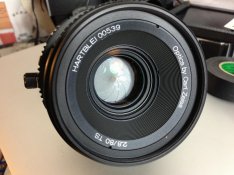Arcturus
Member
- Joined
- Dec 13, 2012
- Messages
- 95
- Format
- Medium Format
I like using vintage medium format folders (1930's-40's), and I notice that they use many more aperture blades than cameras that came after it. There are so many that the opening always stays round, or very close to round at all stops. Average modern lenses usually have the standard 5 straight blades, and premium lenses can have 6 or so. I see the same 5 blades in my 1970's TLR's and rangefinders. So why did lens makers stop using the old style aperture blades in favor of simpler ones if they make those out of focus pentagons that many people find objectionable?
I found a picture on Flickr that shows the type of aaperture blades I'm talking about.
http://www.flickr.com/photos/nesster/4356261367/in/pool-camerapedia
I found a picture on Flickr that shows the type of aaperture blades I'm talking about.
http://www.flickr.com/photos/nesster/4356261367/in/pool-camerapedia











